Card switch: what is it for, how to choose it and connect it correctly
In modern houses there are many rooms and a lot of household electrical appliances. Leaving home, most of the electrical equipment left turned on is disadvantageous due to the empty consumption of electricity.
You have to spend time going around rooms, turning off appliances and lighting. There is a device that can de-energize all the "extra" power supply in one motion - a card switch.
In this material we will consider in detail the principles of operation of card switches, their types and installation features.
The content of the article:
- Home Energy Saving Principles
- Card switch purpose
- Benefit from a card reader in a residential building
- Disconnectable and non-disconnect electrical appliance subnets
- Types of card acceptors
- Features of the installation of card reception switches
- Energy-saving card switch in a residential building
- Conclusions and useful video on the topic
Home Energy Saving Principles
Until the 90s, urban apartments were equipped with the largest number of household appliances. For suburban homes, local energy networks simply did not have enough capacity - even the refrigerator worked intermittently.
Yes, and there was not much available household electrical equipment in those years - a TV, a fridge, a washing machine, a vacuum cleaner, a stereo radio and a radio.
Finally, the cost of an electric kilowatt at that time was low - the lamp in the room or the radio receiver left on only slightly increased the amount of electricity paid.
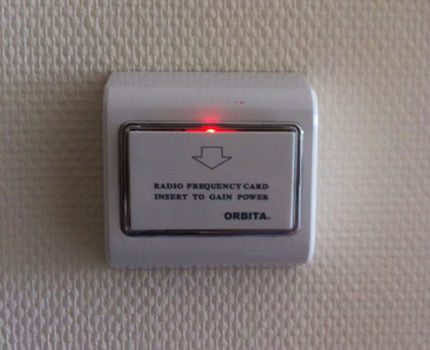
households, contributing to the best possible reduction in energy costs. Left devices on in an empty house - a waste of money
Today the situation is different: in every apartment building there are not a few electrical appliances. It's one thing to keep track of five to six home electricity consumers like a TV or a room lamp. It’s completely different to try to track 20 or more devices that are regularly connected to the mains.
The rhythm of modern life does not allow this, there is always no time. But the desire to pay for extra kilowatts, wasted consumed by "forgotten" gadgets - it is not there either.
To achieve savings in domestic electricity allow card switches. By installing a card reader near the front door, you only need to remove the card from it every time there is no one left in the house - all excess power lines will be de-energized.
Of course, the card wiring product is not capable of deciding which particular power networks of the house to de-energize. However, it must be properly integrated into the home electrical supply network.
Card switch purpose
This energy supply limiting device has been used in hotel complexes for many years. The key card from the room is inserted into the card reader after opening the door lock - the rooms turn on the lighting and household appliances (air conditioning, TV, etc.).
Upon leaving the hotel room, the guest must remove the card from the “pocket” of the switch, de-energizing the secondary power systems.
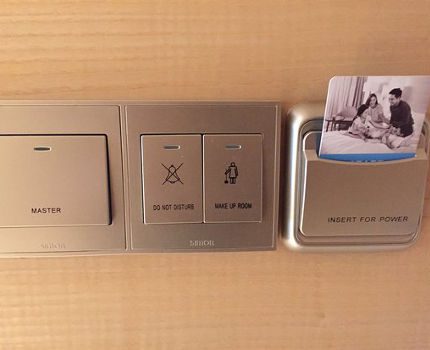
Modern card readers of active power management also ensure the safety of hotel property from personnel (for example, the contents of the bar)
Thus, the hotel optimizes energy costs. Guests must pick up the key card when leaving the room, which means they will not be able to leave the lights on in the bathroom or the working TV with air conditioning.
Estimate the scale of savings. For example, a 22 W LED lamp left turned on for 10 hours will consume 220 W of electricity. For a year such a lamp will be wasted (there is nobody in the room) 80.3 kW.
In Moscow, at a tariff of 5.38 rubles, a lamp that has been left running during the year will “press” 432 rubles. Outwardly, there are dozens of such lamps in the hotel. And taking into account the TVs, air conditioners and other electrical appliances that are not turned off, the amount runs up a decent one.
In addition to the function of de-energizing the electrical subnet, the card-accept switch can be used to shut off water supply during the absence of households.
It is only necessary to equip the water supply inlets with special (normally closed) valves for shutting off the water supply and bring the wired power supply group from them to the card device.
Benefit from a card reader in a residential building
For hotels, equipping rooms with card switches is a necessary measure of saving energy costs. But is a similar device really necessary for a residential building?
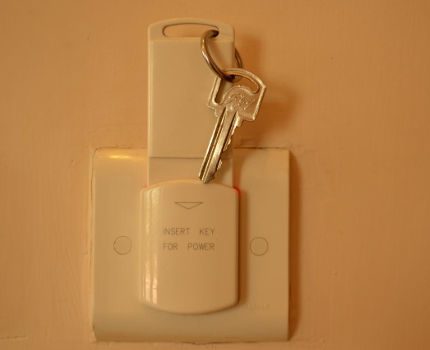
There are contact and key fob switches. The latter are more convenient, since the switch simultaneously serves as a “storage place" for the key fob.
If the apartment or cottage has less than four to five rooms (including a kitchen, a bathroom, etc.), then dividing the house power network into mandatory and secondary lines with disconnecting the latter in the absence of household members, in principle, is not particularly required.
For a small number of rooms it is easier to keep track of yourself than to build a divided power supply, “tied” to the card reader.
However, the modern reality of utility services, prevailing in many cities, forces apartment owners to abandon the central provision of thermal energy - to set electric boilersmount warm floor with electric heaters.
Leaving the house for many hours and leaving the heat generation systems in the active mode of operation, the owner of even a small house spends money in vain.
As for residential real estate with an area of more than 80 m2 - Using a card switch in such a house is certainly beneficial. But the output of disconnected home power lines to the card-reader switch is appropriate only in situations where there are no household members for a long time in the house.
For example, if the apartment is empty in the morning (households diverge to work / study) until the evening, or a country cottage visited by the owners from time to time.
Disconnectable and non-disconnect electrical appliance subnets
Modern electrical wiring complex in residential buildings is formed by several independent groups displayed on separate machines in the shield.
Main goals: simplification of promising repair tasks and the permissibility of using cables of various (required) cross-sections. An extension of these goals will be the division of the wiring groups into two subnets - the primary (non-disconnectable) and secondary (disconnectable).
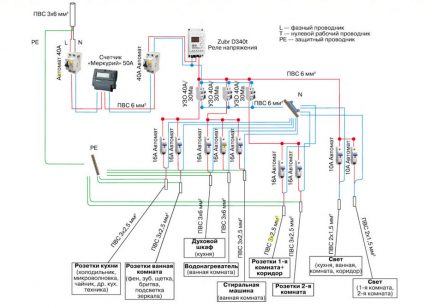
reasons, including the ability to control power for optional groups (subnets). On the image
presents an approximate scheme for the formation of groups of home electrical network
Unswitched subnet. It includes power points for household appliances that need a constant power supply - a refrigerator, an electric stove and a microwave. Food for the last two types of household appliances is usually necessary for the operation of the clocks built into them.
Continuous power supply is also useful for an automatic washing machine - it is able to work in the “delayed washing” mode without the participation of the owner. In the absence of hosts, you may need to use a computer.
For example, to download large files from the Internet. The wiring groups of the non-disconnect subnet of the house are displayed on the machines in the electrical panel.
Disconnectable subnet. It includes all groups of lighting devices (main, auxiliary, scenario lighting, etc.) and power points (sockets), to which equipment from a non-disconnect subnet is not connected.
The disconnected subnet also includes electrical wiring groups for household appliances, the operation of which is not necessary in the absence of households - for example, a boiler and a split system, a TV and a cooker hood, a heated floor on electric heaters, etc.
The groups of the disconnected subnet are displayed to the general switch - the card reader.
Types of card acceptors
Having a similar principle of operation, energy-saving circuit breakers differ in simple and more complicated. The former will suit apartments and houses of relatively small area, the latter will be most convenient in residential complexes with a large number of premises equipped with numerous electrical equipment.
If there is no card in the “pocket”, then the switch contacts are closed - external power is not supplied to the subnets of the premises.
By inserting a card with certain characteristics, the user closes the contacts of the device, activating the supply of electricity to the power points in the premises. Typical card sizes for an energy-saving switch: length from 80 mm; width up to 54 mm; thickness from 0.8 to 1.2 mm.
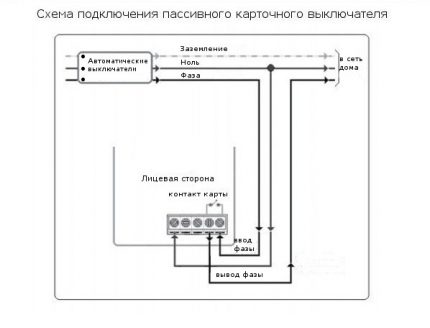
electricity is achieved by interrupting the network through phase wiring
Simple switches (passive)
Turning on the power supply to the network controlled by such a switch can be performed using a standard key card, or any other card of a similar size. For example, you can insert a business card or flip calendar sheet to turn on the card reader to supply electricity.
Such devices are inexpensive and quite effective, so they are used in many hotel and residential complexes.
The ability to replace the original card with a cardboard fragment of the same shape simplifies the task of reproducing the card key in the event of loss of staff samples or the need for a larger number of them (for a cleaner, for example).
Enhanced Switches (Active)
The key card for such devices contains a chip that activates switches of only a certain standard - Temic, Emmarin, Mifare, etc.
Being a full-fledged element of an access control system with the ability to integrate into an online access control system in residential premises, an active card reader will not accept a fake card (for example, from cardboard) as a valid key.
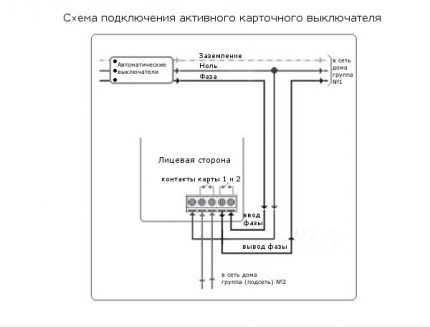
more complex organization. However, the subnets connected to the card reader should be properly built - with the expectation of future use by the owners and maintenance staff
Intelligent switches (smart devices)
They are equipped with key cards that can not only determine the key ownership of a given system, but also recognize the range of its capabilities. Those. activation of power in the entire subnet occurs only on the card of the owner of the house embedded in the card reader.
If a cleaning personnel card is inserted in the smart card reader, the power supply for strictly defined network groups will turn on. According to the cleaning woman’s card, the power supply for lighting and several outlets needed to connect the vacuum cleaner is activated, but, for example, the jacuzzi bathtub and TV will remain de-energized.
Note that, with the exception of key cards of home owners, all other cards for an intelligent card reader for correct programming (a programmer device is necessary) with setting restrictions for each of them. Of course, the card reader unit also needs programmable scripting for accessing the mains supply for each key card.
Features of the installation of card reception switches
Optimally, if card devices intended for controlling the power supply of household subnets are designed for voltage of 220V and 30A, current strength. This will allow the circuit breakers to safely switch the current of the network group to which the most energy-intensive household appliances are connected.
With lower performance characteristics, but with the need to manage network groups with multiple energy consumers, the load on the energy-saving switch will be too high.
For example, among household appliances that develop an increased load on the power grid, one can single out a washing machine, a split system and an electric kettle. Therefore, models of card acceptors designed for currents of less than 30A should be equipped with an additional starter.

The mounting design of the card reader is formed by two main elements - the main body (mechanism) of the device and the mounting frame. The body of the main mechanism of card-receiving devices of some brands is equipped with a removable decorative insert.
Consider the installation procedure for the card switch using the example of the Schneider Electric model:
- having picked up a decorative insert on the mechanism case with a screwdriver, remove it. Unscrew the two fixing screws;
- dismantle the frame and cover;
- fix the wires of the power line, inserting them with the ends stripped from the braid into the corresponding circuit of the contact clamps, tighten with screws;
- insert the housing into the cavity of the mounting box. Depending on the type of mounting box used, either tighten the spacer tabs with two screws or screw in two screws;
- put a frame. Expose the cover, moving it along the frame from top to bottom until the claws of the retaining tabs engage;
- tighten the two screws, put the decorative trim.
Installation of the card device is carried out in plastic mounting boxes, designed for spacers (GOST 8594-80) or for fastening with self-tapping screws. In any case, tighten the screws alternately and gradually.
Energy-saving card switch in a residential building
In everyday life, it is most convenient to use a passive-type card reader: it does not require programming; identical cards; it is permissible to use home-made cards (for example, cardboard) of a suitable size.
Alternatively, you can not take the card with you - put it or hang it next to the switch, then the key card will not be lost and will not be forgotten somewhere outside the house.
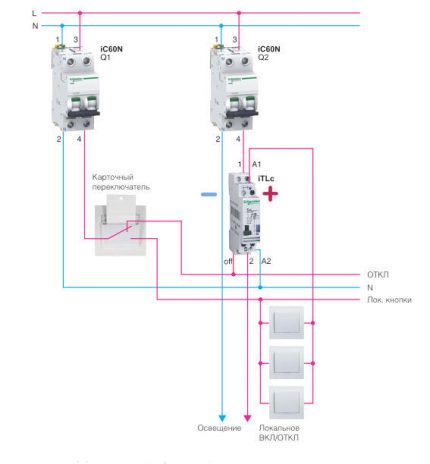
For active devices and smart switches, you need a clear distribution of key cards by access level: the main (activating all energy subsystems) cards - for the owners of the house; limited (activating some power supply points) cards - for maintenance personnel (cleaners, gardeners, etc.).
Each active card is programmed in a special device for the access level, then it is marked for visual recognition.
It should be noted that one day the owner will forget his active key card outside the house, and there is simply no other way to start the power supply to the housing. Therefore, in addition to the main access cards carried by households with them, it is necessary to keep one or two copies of the programmed cards in the house as spare ones.
Conclusions and useful video on the topic
After removing the card from the “pocket” of the switch, the de-energized home subnets will occur after 30 seconds:
The wizard explains how to properly connect a passive-type card device to the served subnet:
The card-controlled switch along with energy savings will allow one movement to turn on the light throughout the house, which is convenient. Indeed, at dusk in the evening it is difficult to find the switch key in the next room. The card reader is a simple device, and it has many benefits.
Do you want to ask a question on the topic of the article, have found flaws in the material, or is there valuable information that you can share with our readers? Please leave comments in the block below.

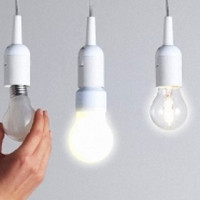 How to choose and correctly connect a three-key switch
How to choose and correctly connect a three-key switch 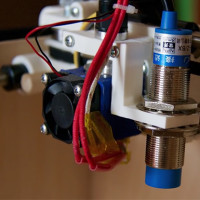 Why do I need a proximity switch + marking and features of its connection
Why do I need a proximity switch + marking and features of its connection 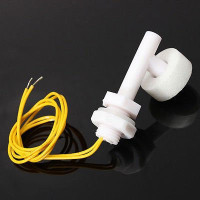 Float switch: what is needed and what to consider when choosing and installing
Float switch: what is needed and what to consider when choosing and installing 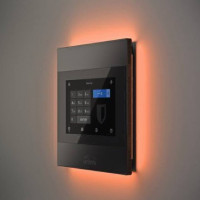 Smart switches: types, labeling, how to choose and connect correctly
Smart switches: types, labeling, how to choose and connect correctly 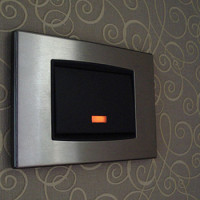 How to connect an LED switch: rules for connecting a backlit switch
How to connect an LED switch: rules for connecting a backlit switch 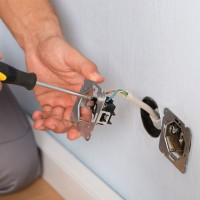 How to connect a passage switch: circuit analysis + step-by-step connection instructions
How to connect a passage switch: circuit analysis + step-by-step connection instructions  How much does it cost to connect gas to a private house: the price of organizing gas supply
How much does it cost to connect gas to a private house: the price of organizing gas supply  The best washing machines with dryer: model rating and customer tips
The best washing machines with dryer: model rating and customer tips  What is the color temperature of light and the nuances of choosing the temperature of the lamps to suit your needs
What is the color temperature of light and the nuances of choosing the temperature of the lamps to suit your needs  Replacement of a geyser in an apartment: replacement paperwork + basic norms and requirements
Replacement of a geyser in an apartment: replacement paperwork + basic norms and requirements
The idea for a living room is, in principle, good, given the fact that new apartments should already be rented out with wiring broken into subnets and optimized for such switches. Otherwise, the question arises - why do I need all these expenses for altering the wiring? Better I will save manually, carefully make sure that no one leaves the light in the toilet on, etc. In general, everything is as always.))
I partially agree with you. The system of switches described in the article is quite practical, but as for me, it is still morally and physically obsolete. Networks, subnets - all this is too complicated for a simple layman and ordinary citizen.
Therefore, smart Chinese have long ago bombarded us with Wi-Fi-bulbs and Wi-Fi-outlets. This is much easier than changing wiring and building a network. In addition, even a student can assemble and connect such a system.
For example, a Wi-Fi-bulb - he left the house in a hurry and forgot to turn it off, he remembered and went to work from a smartphone and corrected the situation. The same story with a Wi-Fi outlet: you go home and want to come to swim right away, turned on the boiler from your smartphone and let it warm up for your arrival. All ingenious is simple.
Such switches were not intended for use in a residential apartment. They came up with them for hotels, holiday homes, etc.
I can’t imagine how much the house should be crammed with constantly working equipment so that such a switch pays off. It is suitable specifically for hotels, offices, production. And in an ordinary apartment, in my opinion, it is useless. Not to mention that the card is easy to lose, break, etc. And then, if someone from the family comes earlier, and he does not have a card, what will he do? Some unnecessary difficulties.
It may be useless for an apartment, but if it is a large cottage, then it is much easier to turn off the electricity with a card than to run through floors and rooms and check if everything is turned off.
The card should always be at home, somewhere near the switch, so that no one from the household has problems.
Valera, Amir described the perspectives to you in the commentary above, and you can lose or break the map. Already today, the Japanese are offering refrigerators reminding that it is time to buy eggs, meat .... Some refrigerators order delivery. Smart irons, having felt that they have been turned on for a long time but are not used, send a question to the owner’s mobile phone: can I turn off? Having not received an answer, they turn off themselves.